- Grades 6-12
- School Leaders
Win a $200 Gift Certificate in Today's Holiday Giveaway! 🎁
Every product is independently selected by our team of teacher-reviewers and editors. Things you buy through our links may earn us a commission.

45 Cool Chemistry Experiments, Demos, and Science Fair Projects
Don’t forget your safety equipment!

Bunsen burners, colorful chemicals, and the possibility of a (controlled) explosion or two? Everybody loves chemistry experiments! We’ve rounded up the best activities, demos, and chemistry science fair projects for kids and teens. Try them in the classroom or at home.
Easy Chemistry Experiments and Activities for All Ages
Chemistry science fair projects.
These chemistry experiments and activities are all easy to do using simple supplies you probably already have. Families can try them at home, or teachers and students can do them together in the classroom.
Mix up some magic milk
Kids love this colorful experiment, which explores the concept of surface tension. This is one of our favorite chemistry experiments to try at home, since the supplies are so basic and the results are so cool!

Taste the Rainbow
Teach your students about diffusion while creating a beautiful and tasty rainbow. You’ll definitely want to have extra Skittles on hand so your class can enjoy a few as well!
Learn more: Skittles Diffusion

Crystallize sweet treats
Crystal science experiments teach kids about supersaturated solutions. This one is easy to do at home, and the results are absolutely delicious!
Learn more: Candy Crystals
Make elephant-sized toothpaste
This fun project uses yeast and a hydrogen peroxide solution to create overflowing “elephant toothpaste.” You can also add an extra fun layer by having kids create toothpaste wrappers for their plastic bottles.

Blow the biggest bubbles you can
Add a few simple ingredients to dish soap solution to create the largest bubbles you’ve ever seen! Kids learn about surface tension as they engineer these bubble-blowing wands.
Learn more: Giant Soap Bubbles

Demonstrate the “magic” leakproof bag
So simple and so amazing! All you need is a zip-top plastic bag, sharp pencils, and some water to blow your kids’ minds. Once they’re suitably impressed, teach them how the “trick” works by explaining the chemistry of polymers.
Learn more: Leakproof Bag

Use apple slices to learn about oxidation
Have students make predictions about what will happen to apple slices when immersed in different liquids, then put those predictions to the test! Finally, have them record their observations.
Learn more: Apple Oxidation
Float a marker man
Their eyes will pop out of their heads when you “levitate” a stick figure right off the table. This experiment works due to the insolubility of dry-erase marker ink in water, combined with the lighter density of the ink.
Learn more: Floating Marker Man

Discover density with hot and cold water
There are a lot of easy science experiments you can do with density. This one is extremely simple, involving only hot and cold water and food coloring, but the visuals make it appealing and fun.
Learn more: Layered Water

Layer more liquids
This density demo is a little more complicated, but the effects are spectacular. Slowly layer liquids like honey, dish soap, water, and rubbing alcohol in a glass. Kids will be amazed when the liquids float one on top of the other like magic (except it is really science).
Learn more: Layered Liquids

Grow a carbon sugar snake
Easy science experiments can still have impressive results. This eye-popping chemical reaction demonstration only requires simple supplies like sugar, baking soda, and sand.
Learn more: Carbon Sugar Snake

Make homemade bouncy balls
These homemade bouncy balls are easy to make since all you need is glue, food coloring, borax powder, cornstarch, and warm water. You’ll want to store them inside a container like a plastic egg because they will flatten out over time.
Learn more: Make Your Own Bouncy Balls

Create eggshell chalk
Eggshells contain calcium, the same material that makes chalk. Grind them up and mix them with flour, water, and food coloring to make your very own sidewalk chalk.
Learn more: Eggshell Chalk

Make naked eggs
This is so cool! Use vinegar to dissolve the calcium carbonate in an eggshell to discover the membrane underneath that holds the egg together. Then, use the “naked” egg for another easy science experiment that demonstrates osmosis .
Learn more: Naked Egg Experiment
Turn milk into plastic
This sounds a lot more complicated than it is, but don’t be afraid to give it a try. Use simple kitchen supplies to create plastic polymers from plain old milk. Sculpt them into cool shapes when you’re done.

Test pH using cabbage
Teach kids about acids and bases without needing pH test strips. Simply boil some red cabbage and use the resulting water to test various substances—acids turn red and bases turn green.
Learn more: Cabbage pH

Clean some old coins
Use common household items to make old oxidized coins clean and shiny again in this simple chemistry experiment. Ask kids to predict (hypothesize) which will work best, then expand the learning by doing some research to explain the results.
Learn more: Cleaning Coins
Blow up a balloon (without blowing)
Chances are good you probably did easy science experiments like this when you were in school yourself. This well-known activity demonstrates the reactions between acids and bases. Fill a bottle with vinegar and a balloon with baking soda. Fit the balloon over the top, shake the baking soda down into the vinegar, and watch the balloon inflate.
Learn more: Balloon Experiments
Assemble a DIY lava lamp
This 1970s trend is back—as an easy science experiment! This activity combines acid/base reactions with density for a totally groovy result.

Explore how sugary drinks affect teeth
The calcium content of eggshells makes them a great stand-in for teeth. Use eggs to explore how soda and juice can stain teeth and wear down the enamel. Expand your learning by trying different toothpaste and toothbrush combinations to see how effective they are.
Learn more: Sugar and Teeth Experiment
Mummify a hot dog
If your kids are fascinated by the Egyptians, they’ll love learning to mummify a hot dog. No need for canopic jars ; just grab some baking soda and get started.
Extinguish flames with carbon dioxide
This is a fiery twist on acid-base experiments. Light a candle and talk about what fire needs in order to survive. Then, create an acid-base reaction and “pour” the carbon dioxide to extinguish the flame. The CO2 gas acts like a liquid, suffocating the fire.

Send secret messages with invisible ink
Turn your kids into secret agents! Write messages with a paintbrush dipped in lemon juice, then hold the paper over a heat source and watch the invisible become visible as oxidation goes to work.
Learn more: Invisible Ink
Set popcorn dancing
This is a fun version of the classic baking soda and vinegar experiment, perfect for the younger crowd. The bubbly mixture causes popcorn to dance around in the water.
Learn more: Dancing Popcorn Experiment
Shoot a soda geyser sky-high
You’ve always wondered if this really works, so it’s time to find out for yourself! Kids will marvel at the chemical reaction that sends diet soda shooting high in the air when Mentos are added.
Learn more: Mentos and Coke Experiment
All of these chemistry experiments are perfect for using the scientific method. Form a hypothesis, alter the variables, and then observe the results! You can simplify these projects for younger kids, or add more complexity for older students.

Break apart covalent bonds
Difficulty: Medium / Materials: Medium
Break the covalent bond of H 2 O into H and O with this simple experiment. You only need simple supplies for this one. Turn it into a science fair project by changing up the variables—does the temperature of the water matter? What happens if you try this with other liquids?
Learn more: Breaking Covalent Bonds
Measure the calories in various foods
Are the calorie counts on your favorite snacks accurate? Build your own calorimeter and find out! This kit from Home Science Tools has all the supplies you’ll need.

Detect latent fingerprints
Forensic science is engrossing and can lead to important career opportunities too. Explore the chemistry needed to detect latent (invisible) fingerprints, just like they do for crime scenes!
Learn more: Fingerprints Project
Use Alka-Seltzer to explore reaction rate
Difficulty: Easy / Materials: Easy
Tweak this basic concept to create a variety of high school chemistry science fair projects. Change the temperature, surface area, pressure, and more to see how reaction rates change.
Determine whether sports drinks really have more electrolytes than other beverages
Difficulty: Medium / Materials: Advanced
Are those pricey sports drinks really worth it? Try this experiment to find out. You’ll need some special equipment for this one; buy a complete kit at Home Science Tools .
Turn flames into a rainbow
You’ll need to get your hands on a few different chemicals for this experiment, but the wow factor will make it worth the effort. Make it a science project by seeing if different materials, air temperature, or other factors change the results.

Discover the size of a mole
The mole is a key concept in chemistry, so it’s important to ensure students really understand it. This experiment uses simple materials like salt and chalk to make an abstract concept more concrete. Make it a project by applying the same procedure to a variety of substances, or determining whether outside variables have an effect on the results.
Learn more: How Big Is a Mole?

Cook up candy to learn mole and molecule calculations
This edible experiment lets students make their own peppermint hard candy while they calculate mass, moles, molecules, and formula weights. Tweak the formulas to create different types of candy and make this into a sweet science fair project!
Learn more: Candy Chemistry

Make soap to understand saponification
Take a closer look at an everyday item: soap! Use oils and other ingredients to make your own soap, learning about esters and saponification. Tinker with the formula to find one that fits a particular set of parameters.
Learn more: Saponification
Uncover the secrets of evaporation
Explore the factors that affect evaporation, then come up with ways to slow them down or speed them up for a simple science fair project.
Learn more: Evaporation
More Chemistry Experiment Science Fair Ideas
These questions and prompts can spark ideas for unique chemistry experiments:
- Compare the properties of sugar and artificial sweeteners.
- Explore the impact of temperature, concentration, and seeding on crystal growth.
- Test various antacids on the market to find the most effective product.
- What is the optimum temperature for yeast production when baking bread from scratch?
- Compare the vitamin C content of various fruits and vegetables.
- How does temperature affect enzyme-catalyzed reactions?
- Investigate the effects of pH on an acid-base chemical reaction.
- Devise a new natural way to test pH levels (such as cabbage leaves).
- What’s the best way to slow down metal oxidation (the form of rust)?
- How do changes in ingredients and method affect the results of a baking recipe?
Like these chemistry experiments? Don’t miss STEM Activities for Kids of All Ages and Interests .
Plus, get all the latest teaching news and ideas when you sign up for our free newsletters.

You Might Also Like

80 Best High School Science Experiments and Projects for Every Subject
Fire up the Bunsen burners! Continue Reading
Copyright © 2024. All rights reserved. 5335 Gate Parkway, Jacksonville, FL 32256
Babble Dabble Do
50 Chemistry Projects That Will Amaze Kids!
February 26, 2019 by Ana Dziengel 5 Comments
Chemistry projects feel like magic , do they not? If you think about some of your favorite science projects, the ones you love to try with your kids or the ones that amazed YOU as a kid, more likely than not most of them involved chemistry.
Now I know a lot of us associate chemistry with lab coats, beakers and specialty ingredients but the reality is there are so many chemistry projects you can do using very simple, easy to find ingredients, often found in your own pantry. And since these types of simple chemistry projects use relatively safe ingredients, they are perfect to try with younger kids, ie. preschool and elementary aged children! In fact I think it’s so important for young kids to have a positive association with chemistry from a young age that fosters a love of this branch of science.
When most children are finally exposed to chemistry in school, it is at the high school level where the subject turns complex quickly; hopefully giving kids a chance to have fun at young age mixing up concoctions and watching chemical reactions will help carry their interest through the more complicated days of study ahead.
This post is a GIANT compilation of chemistry projects that would be great for the science fair, classroom demos, or at home science with your kids.
Before we get started let’s talk a little bit about what chemistry is and for parents I also included a section covering How to Do Chemistry Projects at Home. If you are a classroom teacher you can skip this section and head right to the projects here.
What is chemistry?
Chemistry is the branch of science that studies matter (anything that has mass and takes up space) and its properties, and how different substances (especially molecules and their atoms) interact, combine, and change to form new substances.
Here are some important definitions to know when working on chemistry projects:
- Element A substance that cannot be separated into any further substances. There are 120 known elements.
- Atom The smallest particle of an element
- Molecule Groups of atoms held together by a chemical bond.
- Ion An atom or molecule that has an electric charge
While most people think of chemistry purely in terms of chemical reactions, chemistry also covers the study of the states of matter as well as the density of substances.
The five branches of chemistry are:
- Analytical chemistry
- Physical chemistry
- Organic chemistry
- Inorganic chemistry
- Biochemistry
Read more about what each branch covers here.
How to Do Chemistry Projects at Home
Many chemistry projects can be done at home using simple materials and are a great way to foster a love of science in kids! I wholeheartedly believe that a wow factor in a project engages and inspires kids to learn more. If you want to try chemistry projects at home here are some suggestions and precautions:
Safety First
Even though most of the projects in this list use safe, easy to find materials they should be used with safety precautions and under adult supervision. Why? Sometimes the chemical reaction that ensues can irritate the skin or eye, can be harmful if swallowed, or is just plain sticky or messy and adults should be on hand to supervise use . Also be advised that there are a few projects on this list that do use materials that are unsafe for kids to handle. These projects are meant to be demonstrations only and are labeled accordingly.
- Use household items for chemistry The classic chemistry project that never fails to impress is the reaction of baking soda (sodium bicarbonate) and vinegar (look for a number of variations on this classic in our Acids and Bases section) but there are lots of other great ingredients for chemistry to find in your kitchen including sugar, salt, yeast, lemons, dish soap, milk, Kool- Aid, cabbage, gelatin, and food coloring to name a few…before you order any materials online, try some projects with pantry essentials.
- Safety Goggles
- Large plastic beakers
- Prepare for mess Since a lot of chemistry involves reactions and the ensuing mess, be sure to choose a place in your home that you can easily clean up and where you won’t worry about getting dirty. A patio, breakfast area, or the garage are great choices.
- Generous work area Be sure to have a large table available so everyone has plenty of room to work and/or view projects without bumping into each other.
- Access to Water Clean up is always easier with water at the ready! Choose a location near a hose or shop sink.
Managing Messes
- Hose it down Depending on the project I suggest doing super messy chemical reactions outside. That way spills can be hosed down easily.
- Painter’s Tarp & Trays If you cannot go outside a large plastic painter’s tarp is a great way to contain spills and mess. I also highly recommend doing projects on trays or cookie sheets. The raised edges help contain bubbly brews and are easy to dump out and wash.
- Dump station Have a bucket nearby to act as dump station for liquid reactions. Bring it around a table and dump at each station.
- Think about disposal Vinegar kills grass! Slime bits clogs drains! Be sure to consider where you can dump out the liquids safely.
Chemistry Projects for Kids
The following chemistry projects for kids are sorted by topic: Chemical Reactions, Acids and Bases, Carbon Reactions, Chromatography, Colloids & Solutions, Polymers, and Crystals.
Please note that many if these projects could fit in two or more categories in this post as they demonstrate various scientific and chemical processes. I only classified them once on this list.
Chemistry Projects with Chemical Reactions
What is a chemical reaction.
Chemical reactions occur when the chemical bonds in a substance are either destroyed or created. In other words the bonds in a molecule are broken during a chemical reaction and the atoms rearranged to create new molecules. Interestingly enough the number of original atoms does not change during the reaction, they are simply reconfigured.
An easy way to explain chemical reactions to kids is to use this analogy: Atoms are like letters, molecules are like words. Chemistry is like taking apart words and rearranging the letters to form a new word.
Read more about chemical reactions here.
Chemical Reactions Projects:
1. milk painting, 2. citrus battery, 3. elephant toothpaste.
<span data-mce-type=”bookmark” style=”display: inline-block; width: 0px; overflow: hidden; line-height: 0;” class=”mce_SELRES_start”></span>
4. Density Lava Lamps
To make a density lava lamp fill a plastic bottle with the following liquids: Clear corn syrup, water with a few drops of food coloring, and layer of vegetable oil. Be sure to leave a space at the top of the bottle. Wait until the liquids settle then add in a tablet of extra strength alka seltzer. Watch as the alka seltzer and water react and bubble up through the oil layer. To see this in a step by step video check out this video (Pssst this is one of our students!!!)

5. Plastic Milk and Curds & Whey Experiment
6 . color mixing.
Pour water into three clear plastic cups, then add blue, red, and yellow food coloring to each. Have an additional cup full of uncolored water available as well. Give your child an empty ice cube tray and pipettes and let them create different colors by mixing different ratios of two different primary colors in each ice cube compartment. The secondary colors are new colors created from two primary colors. This is a simple visual of how chemical reactions work.
7. Chemistry Clock
8. blow balloons with yeast and sugar, 9. shiny pennies.
- Collect dirty tarnished pennies.
- Pour different acidic liquids into shallow containers. Try vinegar, salsa, lemon & lime juice.
- Add a teaspoon of salt to each container and stir to combine.
- Place a handful of pennies in each container and soak for 5 minutes.
- Remove them from the solution and rinse in soapy water. Let dry on separate paper towels.
- Compare the results! Which ones are shiniest? Which are dull? Did any turn green?
Acids are corrosive and sour tasting. Liquids such as vinegar, lemon juice, and tomato juice are acids. Pennies are made from copper which tarnishes (turns dark) when exposed to oxygen over time. Placing the copper pennies in an acid will clean the copper oxide off them and make them shiny again.
Learn about Acids and Bases
Most liquids are either an acid or a base. Liquids with lots of hydrogen ions in them are considered acids. Liquids with many hydroxide ions are bases. Scientists use a scale called the ph scale to measure how acidic or basic a liquid is. The more hydrogen ions in a liquid the more acidic it is and ranks low on the ph scale. The more hydroxide ions in a liquid the more basic it is and ranks high on the ph scale. You can see what that looks like here.
When acids and bases are mixed chemical reactions occur and the solution becomes neutralized.
Acid and Bases Projects:
1. baking soda & vinegar volcano, 2. lemon volcano, 3. the colorful cabbage juice science experiment and acid base experiment with cabbage, 4. dancing rice, 5. green eggs & ham, 6. bubbly citric acid brew , 7. baking soda vs baking powder science experiment, 8. exploding bags, 9. rainbow rubber eggs , 10. surprise eggs , 11. rainbow wizard’s brew, chemistry projects with fire (carbon reactions).
Carbon is the most important element for life. Chemicals that contain carbon are called organic compounds. Carbon has two main forms: The first is in the hard form of diamonds and graphite, and the second is the impure form found in charcoal, coal and soot.
SAFTEY WARNING: Carbon reactions are always fascinating to watch however the presence of fire means that these experiments must be supervised by adults at all times!
Carbon Reactions Projects:
1. smoking fingers, 2. fire snake, 3. silver egg, 4. invisible ink, chromatography.
Chromatography is the process of separating mixtures. We usually think of it in terms of color hence the prefix -chroma, however in chemistry is means simply a method of separating mixtures by letting them slowly move past each other. It applies to both liquids and gasses. This is wonderful in-depth explanation of chromatography.
Chromatography Projects:
1. chromatography .
In this project you will separate the color black into other colors. Fold a coffee filter in half. Fold in half two more times until you have a triangular shape. Color the tip of the coffee filter with washable black marker. Get a good coat of ink on the filter. Add a small amount of water to a plastic cup. Place the black tip of the coffee filter in the cup Wait and observe. Come back to the filter after an hour or two and see what happens to the ink. As the coffee filter absorbs water through capillary action, the black ink moves through the filter and is separated by the water into other colors. You should see blue, green and even red as the water separates the ink.
2. Chromatography Flowers
3. chromatography art, 4. chromatography bags, colloids and solutions/solubility.
Colloids and Solutions are two types of homogenous mixtures.
- Colloids are mixtures in which a small particles of a substance are suspended throughout another substance but not chemically bonded. They are stable though and do not separate. Examples of colloids are gelatin, butter, mayonnaise, fog and smoke.
- Solutions are mixtures in which the particles of one substance are completely dissolved in another substance. The solute is the substance being dissolved and the solvent is the substance doing the dissolving. An example of a solution is saltwater.
If you want a more in-depth primer on solutions and colloids hop over here .
Colloid Projects:
1. colloid examples, 2. oobleck , 3. make butter , 4. gelatin streaking, solutions/solubility projects:, 5. ice sculptures , 6. ice cream in a bag.
A printable of the science facts at play here
7. Skittles Science
8. magical water blossoms <span data-mce-type=”bookmark” style=”display: inline-block; width: 0px; overflow: hidden; line-height: 0;” class=”mce_selres_start”></span>, 9. diffusion art, 10. paint solubility , 11. bleeding blossoms .
A polymer is a substance made up of a long chain of molecules. Polymers are typically flexible materials like plastic or gum.
The classic polymer kids LOVE to make is slime! Glue is already a polymer but when combined with sodium tetraborate (borax ) the protein molecules of the glue and the borate ions crosslink, making it harder for the molecules to move and forming the gooey, sticky, substance we know as slime.
Other polymers you are probably familiar with are plastic bags, balloons, instant snow, and even the powdery substance found in diapers that expands when wet.
Polymer Projects:
1. best basic slime .
Bonus: Get the Science Behind Slime printable here
2. Heat Sensitive Slime
3. diy bouncy balls, 4. magic plastic bag experiment, 5. instant terrariums, 6. how to make paper, 7. skewer through balloon , 8. dry erase figure and dry erase drawings, 9. recycled plastic flowers.
Crystals are a type of material that is formed by patterns of repeating molecules. There are four types of chemical bonds in crystals and therefore four categories of crystals. These are: Covalent, Molecular, Metallic, and Ionic Crystals. You can grow crystals by mixing up a super saturated solution (usually with a type of salt and water) and letting it settle over time so crystals will form. Check out the various types of easy to grow crystal below and go here to read more about the science of crystals .
Crystals Projects:
1. classic borax crystals , 2. overnight crystal garden, 3. egg geodes, 4. crystal wind catchers, 5. crystal landscapes, 6. candy geodes , 7. salt crystals, conclusion & more.
Alright you guys, do you feel like you have some good project ideas for exploring chemistry with kids? Many of these will make greats science fair projects. Be sure to start with them as a topic then start asking questions, form a hypotheses, and do some experiments.
Now I have to admit that I really fell in love with chemistry projects as an adult. Working with kids in camp, after school, and with my own kids at home I’ve had the chance to try fun chemistry projects and discovered that I love watching chemical reactions AND the reactions on the faces of kids and bystanders during demonstration or project!
If you have kids who fall in love with this branch of science please do check out the incredible book series Elements , Molecules , and Reactions by Theodore Gray (see the series in our Amazon science ideas list here ) The books are stunning, informative, easy to understand and, wait for it…funny!
Another valuable resource for kids who love chemistry is Mel Science’s Chemistry subscription box. They send you a starter kit for free with all the materials you’ll need and then each month you get a new chemistry experiment delivered to your door! This is great product because a lot of specialty chemistry ingredients are hard to find and these kits simplify getting the materials you need! Check it out here:
Are you passionate about raising creative kids?
Join over 22,179 parents and educators who want connect with kids and nurture their creative process through magical, easy projects you can do TOGETHER.
Subscribe to our email list to receive project ideas as well as offers for some our creative products.
If you want to read our privacy policy before subscribing, hop over here.
February 26, 2019 at 10:31 pm
These were some really awesome projects. I really liked the Citrus Battery projects. It seems simple and easy for a young kid. I wish schools should give more focus to such experiments instead of shoving down the theoretical knowledge down the throat of young kids.
Carol Biggs says
March 1, 2019 at 4:58 am
Is all of this info available on book form?
Ana Dziengel says
March 6, 2019 at 5:49 am
Not at this time but that’s a great idea!
Betsy Mitten says
March 5, 2019 at 10:43 am
Thank you for making this fantastic collection of experiments with clear directions and easy to understand explanations of the science behind the fun! I know I’ll refer to this list often. I especially appreciate the way the experiments are classified/organized. I teach art with science connections and we are already planning on chalkboard and magnetic slime :). I’ll be sure to tag Babble Dabble Do when I post photos of work inspired by this on target collection!
Kyra Rodriguez says
March 5, 2019 at 10:54 pm
These are all great ideas! I’m pretty sure the kids will have fun and love this activities
Leave a Reply Cancel reply
Your email address will not be published. Required fields are marked *
Save my name, email, and website in this browser for the next time I comment.
Pin It on Pinterest
Get Your ALL ACCESS Shop Pass here →
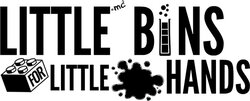
65 Amazing Chemistry Experiments for Kids
Chemistry is so much fun, and we have tons of cool chemistry experiments to share with you. Like our awesome physics experiments , we decided we needed to put together a list of fun chemistry projects kids can do at home or in the classroom. Check out these examples of easy chemical reactions below!
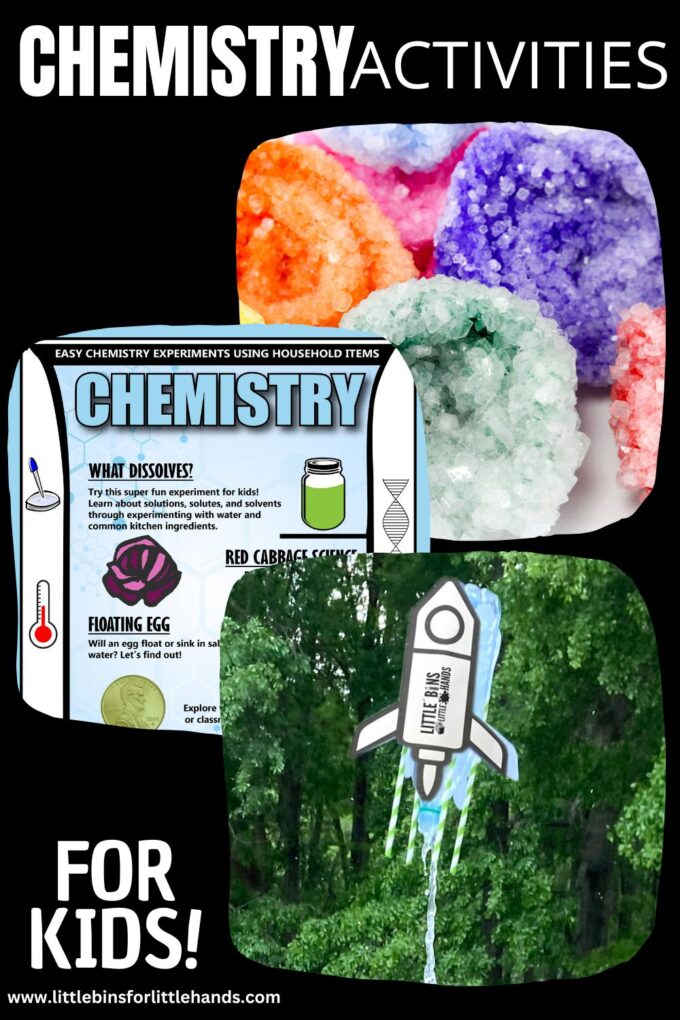
Chemistry Experiments You Want To Try
We have divided our chemistry experiments below into chemical reactions, acids and bases, chromatography, solutions, polymers, and crystals. Some chemistry experiments also explore concepts in physics .
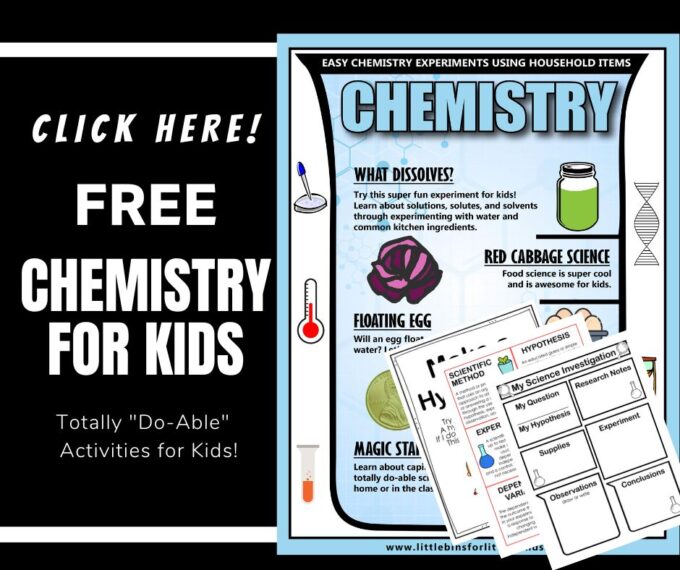
Chemical Reactions
A chemical reaction is a process where two or more substances react together to form a new chemical substance. This might look like a gas formed, cooking or baking, milk souring, etc.
Sometimes a physical change occurs, like our popcorn experiment or melting crayons, rather than a chemical change . However, these experiments below are all great examples of chemical change, where a new substance is formed.
CHECK OUT: Examples Of Physical Change and Chemical Change Examples
Can chemical reactions happen safely at home or in the classroom? Absolutely! This is one of the most fun parts of chemistry for kids, and you will find lots of ideas below for safe chemical reactions you can do with your junior scientists.

Acids And Bases
Acids and bases are important for many chemical processes in everyday life. An acid has hydrogen ions and can donate protons. Acids taste sour and have a pH from 0 to 7. Vinegar and citric acid are examples of acids.
Bases are molecules that can accept hydrogen ions. They have a pH higher than seven and can taste bitter. Sodium bicarbonate or baking soda and ammonia are examples of bases. Learn more about the pH scale.
Vinegar and baking soda experiments are classic acid-base reactions. You’ll also find experiments that use an acid such as vinegar or lemon juice. We have so many fun variations that your kids will love to try! Check out these acid-base chemistry experiments below.
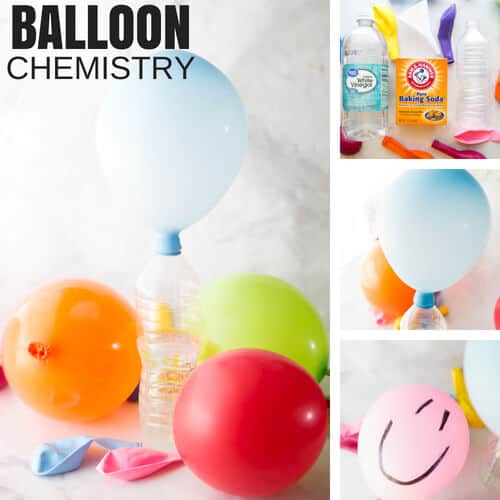
Chromatography
Chromatography is a technique that involves the separation of a mixture into its parts so you can see each one individually.
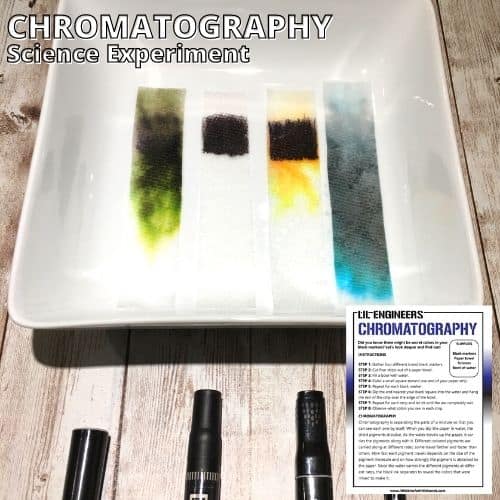
A solution is a mixture of 2 or more solutes dissolved in a solvent up to its solubility limit. It most often refers to liquids, but solutions, gases, and solids are also possible. A solution will have its components evenly distributed throughout the mixture.
Chemistry experiments involving solutions are great for kids. Gather liquids you commonly find in your kitchen, oil, water, detergent, etc., and explore what dissolves.

A polymer is a huge molecule made of many smaller molecules layered together in repeating patterns called monomers. Putty, slime, and cornstarch are all examples of polymers. Learn more about the science of slime polymers .
Making slime is great for at-home chemistry! It’s also a classic middle school science demonstration for the classroom. Here are a few of our favorite slime recipes to get you started.
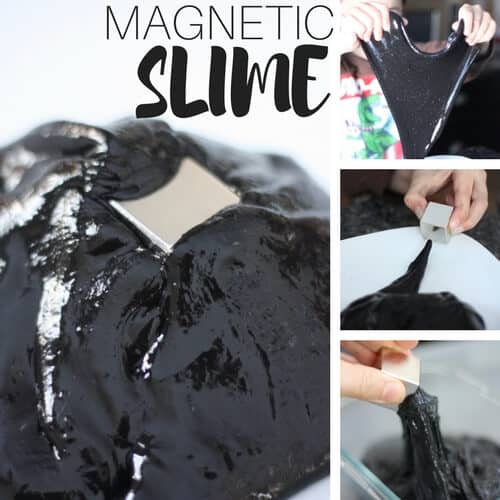
non-Newtonian Fluids
Learn how to make oobleck ! Explore polymers with a simple cornstarch and water mixture.
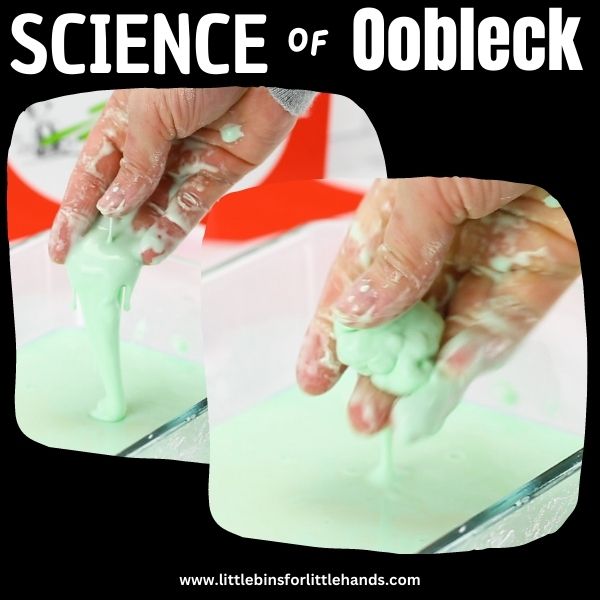
A crystal is a solid material with a highly ordered internal structure of atoms, molecules, or ions held together by chemical bonds. Grow crystals and observe them by mixing a super-saturated solution and leaving it for several days to let the crystals form.
Simple to grow and taste-safe, a sugar crystals experiment is more accessible for younger kids, but you can also try growing borax crystals for older kids.
Check out our fun theme variations of growing crystals too!
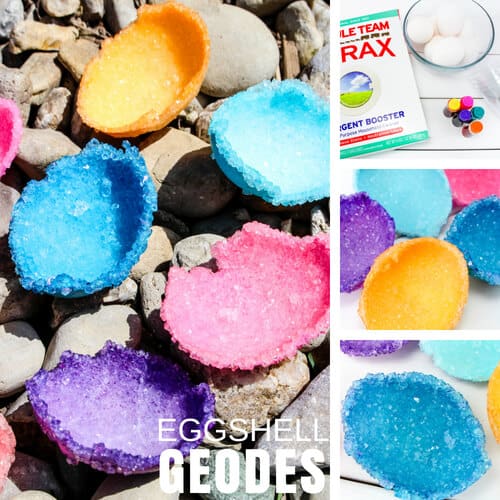
Chemistry For Preschoolers
Let’s keep it basic for our younger or junior scientists! Chemistry is all about how different materials are put together and what they are made up of, like atoms and molecules.
What can you do with your youngest scientists? While working 1-1 or in a very small group is ideal, you can explore chemistry in a few fun ways that don’t require a lengthy setup or a lot of directions to follow. Do NOT overcomplicate the ideas!
Take, for example, our very first baking soda science experiment (age 3). So simple to set up, but so lovely to watch the amazement on my son’s face.
Check out these fun ways for preschoolers to explore science…
- Make liquid mixtures! Mix water and oil in a jar, let it rest, and observe what happens.
- Make solid mixtures! Mix two solid items and observe the changes!
- Mix a solid and a liquid! Add ice to a drink and observe the changes!
- Make a reaction! Set up a tray with baking soda in small cups and colored vinegar in small cups with pipettes. Mix and observe!
- Make oobleck ! Mix cornstarch and water for a weird and messy science activity.
- Explore characteristics of things! Use new science words to describe how different materials feel. Explore squishy, hard, rough, smooth, wet, etc…
Much of preschool science is about you sharing new experiences with them that are relatable and simple. A sk questions, share new words, and offer verbal prompts to get them to communicate with you about what they see!
Chemistry Science Fair Projects
Science projects are excellent tools for older kids to demonstrate their knowledge of science. They can also be used in various environments, including classrooms, homeschools, and groups.
Kids can take everything they have learned about using the scientific method , stating a hypothesis, choosing variables , and analyzing and presenting data.
Want to turn one of these fun chemistry experiments into a science project? Then you will want to check out these helpful resources.
- Easy Science Fair Projects
- Science Project Tips From A Teacher
- Science Fair Board Ideas
More Helpful Science Resources
Here are a few resources that will help you introduce science more effectively to your kiddos or students and feel confident yourself when presenting materials. You’ll find helpful free printables throughout.
- Best Science Practices (as it relates to the scientific method)
- Science Vocabulary
- 8 Science Books for Kids
- All About Scientists
- Free Science Worksheets
- Science Supplies List
- Science Tools for Kids
- Scientific Method for Kids
- Citizen Science Guide
- Join us in the Club
Printable Science Projects For Kids
If you’re looking to grab all of our printable science projects in one convenient place plus exclusive worksheets and bonuses like a STEAM Project pack, our Science Project Pack is what you need! Over 300+ Pages!
- 90+ classic science activities with journal pages, supply lists, set up and process, and science information. NEW! Activity-specific observation pages!
- Best science practices posters and our original science method process folders for extra alternatives!
- Be a Collector activities pack introduces kids to the world of making collections through the eyes of a scientist. What will they collect first?
- Know the Words Science vocabulary pack includes flashcards, crosswords, and word searches that illuminate keywords in the experiments!
- My science journal writing prompts explore what it means to be a scientist!!
- Bonus STEAM Project Pack: Art meets science with doable projects!
- Bonus Quick Grab Packs for Biology, Earth Science, Chemistry, and Physics
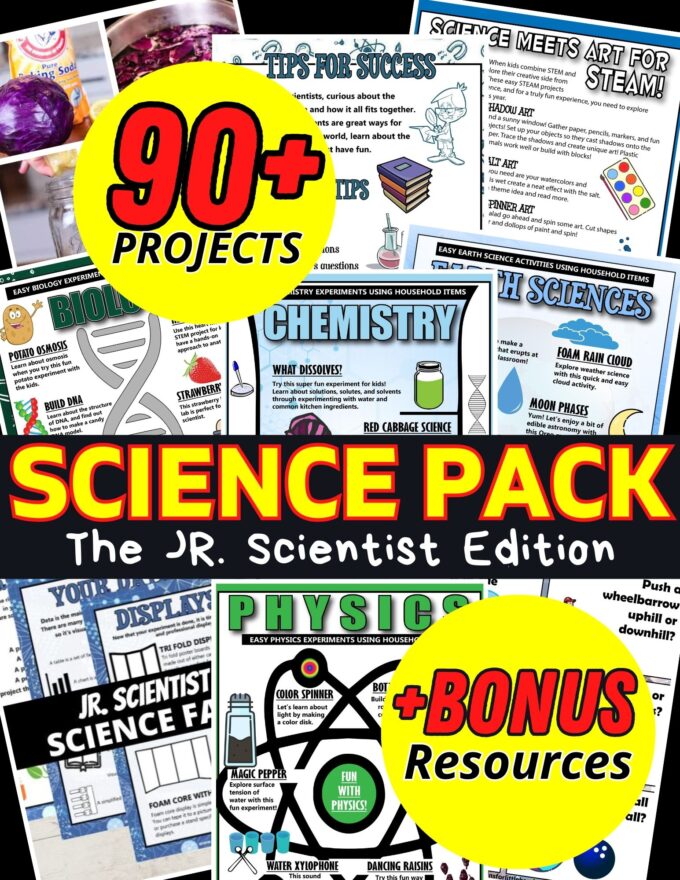
17 Comments
- Pingback: Homemade Sand Slime Recipe for Kids Summer Science Activity
- Pingback: Magic Milk Classic Science Experiment Kids Science
- Pingback: Children to Leaders Foundation | 18 Great Online Resources to Get Your Child into Science
- Pingback: Balloon Baking Soda Vinegar Science Experiment for Kids
- Pingback: Erupting Apple Science and Apple Volcano Chemistry Activity for Kids
- Pingback: Simple Physics Activities Science Experiments STEM Ideas for Kids
- Pingback: How to Get Slime Out of Clothes (2 Methods to Try!)
- Pingback: How to Incorporate Chemistry at Home
- Pingback: Winter Magic Milk Science Project for Snowman Science Activities
- Pingback: Coffee Filter Flowers Science and STEAM Activity for Kids
- Pingback: Crystal Flowers Spring Science Experiment and Craft for Mother Day
- Pingback: Erupting Lemon Volcano Chemistry for Kids Science Activities
- Pingback: Grow Sugar Crystals for Edible Rock Candy Chemistry Experiment
- Pingback: 187Great Online Resources to Get Your Child into Science
- Pingback: The BEST Very Simple Science Experiments for Kids to Try Anywhere
- Pingback: Simple Ways To Take STEAM Outdoors This Summer
- Pingback: Geometric Bubble STEM Activity for Kids Summer Science
Comments are closed.

Subscribe to receive a free 5-Day STEM Challenge Guide
~ projects to try now ~.
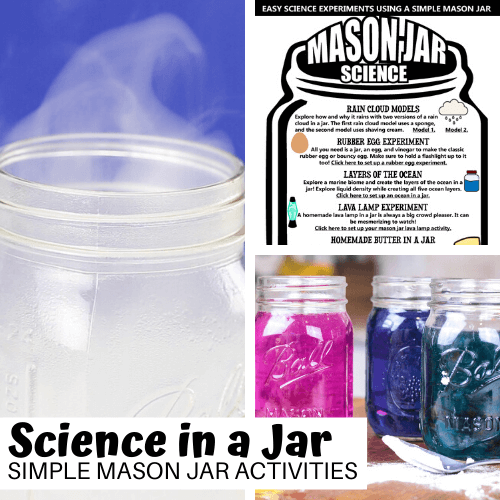
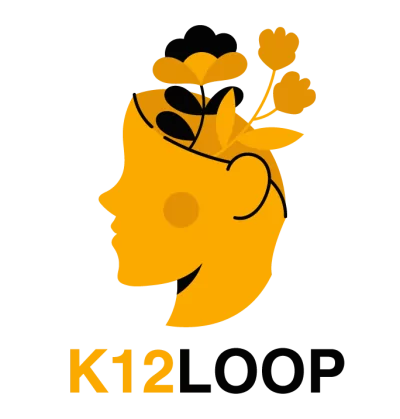
13 Awesome Chemical Reaction Experiments You Can Do At Home
Categories Activities & Ideas
Kids love to play mad scientist. And what better way to get kids excited about chemistry than with a few awesome chemical reaction experiments you can do at home?
Chemistry is an important branch of science that plays a big role in our everyday lives – so it’s definitely a subject children should learn about.
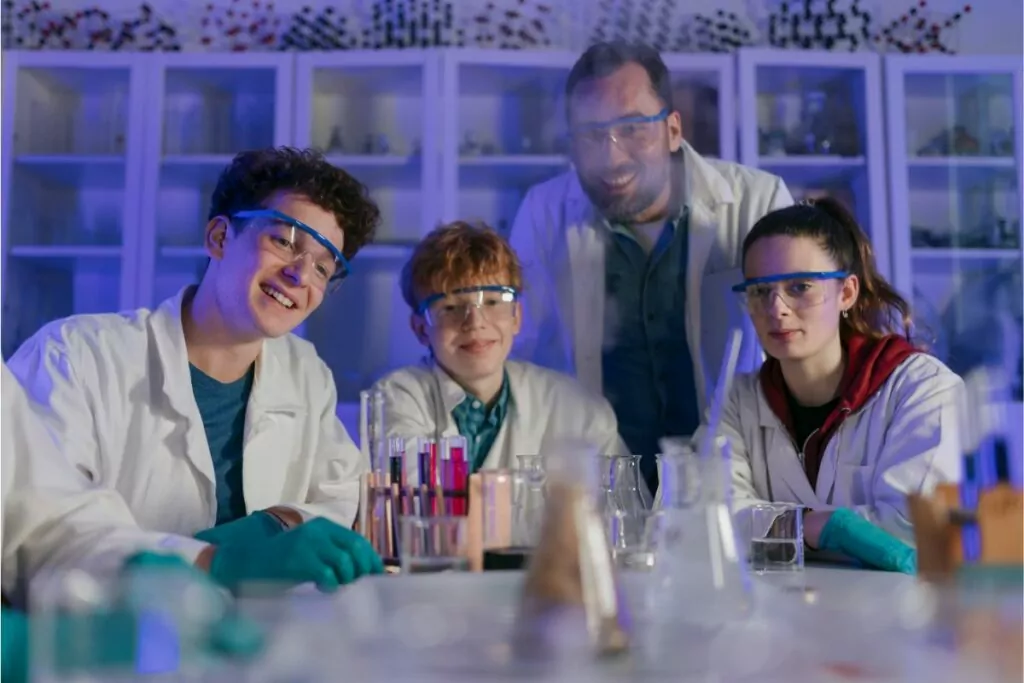
Luckily, chemistry is like performing magic – it’s fun to learn and do!
So, with that said, here are some awesome chemical experiments that can be done at home, all just as fun as they are educational.
Just remember: For health and safety, just make sure to supervise your child while doing the following experiments. If you’re a teacher, conduct these experiments in class or have the child’s parents supervise them at home.
1. Mentos & Diet Soda Chemical Volcano Eruption
Mixing mentos and diet soda is a classic experiment that produces a large chemical reaction that’s ideal for showing kids what chemistry is capable of. It’s safe and non-toxic, but the experiment can get messy, so it’s best to do it outdoors!
For this chemical reaction experiment, all you’ll need are a two-liter bottle of diet soda, a test tube or sheet of paper, an index card, and Mentos candies. You can use normal soda instead of diet soda, as well as M&Ms or Skittles instead of Mentos.
2. Baking Soda And Vinegar Balloon Experiment
If you have never seen a self-inflating balloon, this awesome chemical reaction experiment is sure to amaze the kids. The best thing is that baking soda and vinegar are common household items, so this experiment is easy enough to do at home.
All it involves is mixing baking soda and vinegar in a bottle and placing a balloon on the open end. The chemical reaction between baking soda and vinegar will release carbon dioxide gas that will inflate the balloon.
3. Green Flames
Copper sulfate is another item that can be easily found in most homes, but what’s special about it is that it can turn flames green. This chemical reaction experiment is best done in a fireplace or with a small controlled flame.
This is another awesome experiment that’s simple to do. Simply sprinkle copper sulfate onto a flame to see the color turn blue. You can also use alcohol or an alcohol-based fuel before lighting to achieve a brighter green color.
4. Fireproof Balloon
If you have more balloons left over from the baking soda and vinegar balloon experiment shown above, creating a fireproof balloon is another awesome chemical reaction experiment that’s easy to do and sure to impress.
For this experiment, all you need are two balloons, 50 milliliters of water, a syringe, and a candle or lighter. Simply blow two balloons up, one with 50ml of water added using the syringe. Hold each balloon over a candle to see which one bursts!
5. Foaming Volcano At Home Experiment
The foaming volcano experiment is similar to the baking soda and vinegar experiment except that it’s less explosive and involves different items. It uses baking soda, liquid soap, red food coloring, and acetic acid to create a foaming chemical reaction.
All it involves is using plasticine to create a volcano, then filling the inside with baking soda, a few drops of food coloring, and liquid soap. The last step is adding the acetic acid to watch the volcano erupt. Perform the experiment outside or in a tray to avoid mess!
6. Ice Cream In A Bag
Teach children that cooking also involves chemistry! This ice cream in a bag chemical reaction experiment is a great way to teach kids about freezing point depression, creating a tasty treat that they can also eat afterward.
The main items you’ll need for this experiment include zipper-top bags, ice, sodium chloride as table salt or rock salt, and ingredients for the ice cream, which are sugar, milk, whipping cream, and vanilla flavoring.
7. Elephant Toothpaste
This elephant toothpaste experiment is another simple chemical reaction that you can do at home using common household items. All you’ll need are an empty bottle (plastic or glass), 6% hydrogen peroxide, dry yeast, dish soap, food coloring, and warm water.
Similar to the foaming volcano, this elephant toothpaste experiment creates a chemical reaction that will see the bottle overflow with a foamy liquid. To make it extra fun, conduct the experiment with different food coloring!
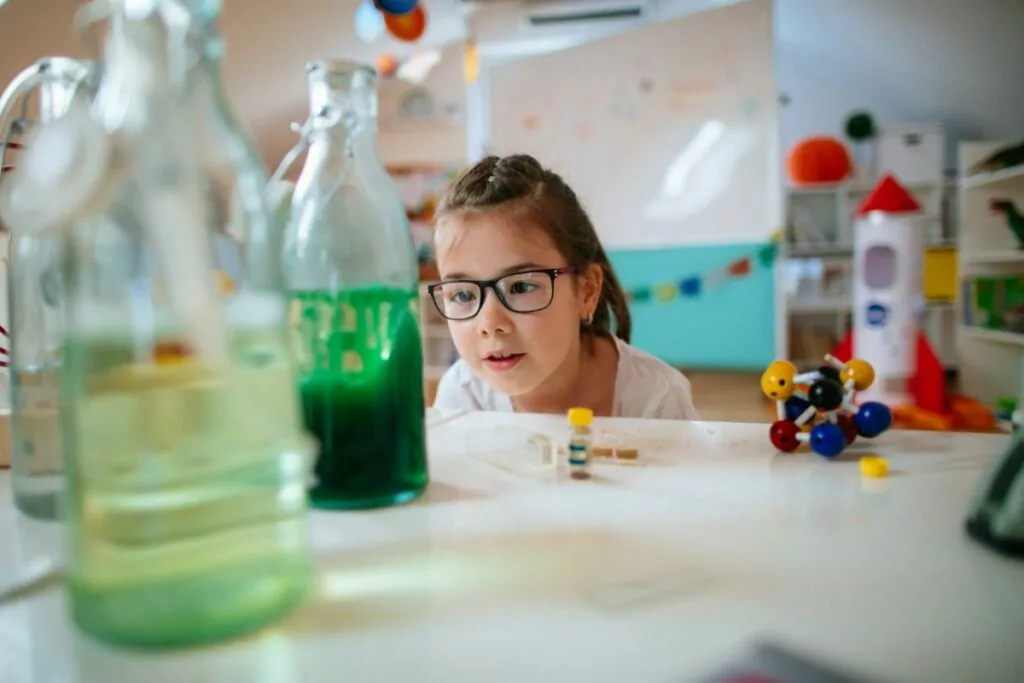
8. Smoke Without Fire Experiment
“There’s no smoke without fire” unless you’re a chemist! This fun smoke-without-fire experiment demonstrates an awesome chemical reaction that creates smoke using a combination of concentrated hydrochloric acid and ammonia.
You will need some science equipment to perform this experiment, which includes three flasks connected by gas pipes. The chemical reaction produces a slow release of white smoke with, you guessed it, no fire or sparks.
9. Liquid Layer Density Tower
Density towers, or density columns, are a great way to show and explain the density levels of different liquids. You can use honey, corn syrup or pancake syrup, liquid dishwashing soap, water (with food coloring if desired), vegetable oil, rubbing alcohol, and lamp oil.
When you have a jar or container, the key is to put the heavier liquids in first, then pour the next liquids in using the side of the container. Even if you don’t get it right the first time, it’s a fun experiment that also creates a colorful display item!
If you and the kids don’t mind getting messy, this slime experiment is a fun chemical reaction that will create a thick, stretchy slime that becomes firmer and less sticky the more it’s played with. You can also add food coloring to create different colors of slime!
For this chemical reaction experiment, you’ll need borax powder, water, glue, and food coloring if you want to add color to the slime. You’ll also need a bowl, jar or measuring cup, and teaspoon for mixing.
11. Ignite A Candle With A Battery
Show your class that it’s possible to light a candle without matches or lighters with this awesome battery experiment! All it requires is an AA battery, chewing gum wrapper, cotton wool, scissors, and a candle.
You might not know this, but the chewing gum wrapper is coated with a layer of aluminum. As a good electrical conductor, the wrapper will generate an electric current when connected to the battery. The aluminum will heat up and light the cotton, which will ignite the candle.
12. DIY Lava Lamp
Lava lamps are awesome, so why not make a DIY one at home using an awesome chemical reaction? Although this DIY lava lamp won’t shine as brightly as a regular lava lamp, it’s still a fun experiment that will teach the kids about density.
The end result is a colorful liquid (use any kind of food coloring you like) with floating bubbles that can make a great bedroom ornament. It’s quick and simple, too, requiring just 30 minutes to create overall.
13. Homemade Science Christmas Ornament
Perfect for the holidays, this homemade science Christmas ornament experiment will get the kids to create glowing crystal icicles that can be hung outside or on the Christmas tree. It’s simple as well, only requiring borax powder, pipe cleaners, and string or twine.
To perform this chemical reaction experiment, you’ll need to add boiling hot water to a glass jar with borax. Twist the pipe cleaner around a pencil or pen to create a winding shape, then lower the pipe cleaner into the mixture with string. Leave until crystals start to form!
So there you have it: a list of awesome chemical experiments you can do at home to teach kids about the fascinating world of chemistry. These experiments are fun, educational, and sure to amaze kids of all ages!
Don’t forget: For health and safety reasons, just make sure to supervise your child while doing the above experiments or, if you’re a teacher, conduct the experiments in class or have the child’s parents supervise them at home.
- Recent Posts
- Homeschooling In High School: Pros And Cons - February 24, 2024
- How Do I Withdraw My Child From School To Homeschool? - February 23, 2024
- How To Not Go Crazy Homeschooling Kids: A Guide For Frazzled Parents - February 22, 2024
Related Posts:

Leave a comment Cancel reply
Your email address will not be published. Required fields are marked *
Save my name, email, and website in this browser for the next time I comment.
- Science, Tech, Math ›
- Chemistry ›
- Projects & Experiments ›
10 Amazing Chemical Reactions
Try these cool experiments in your school science lab.
- Projects & Experiments
- Chemical Laws
- Periodic Table
- Scientific Method
- Biochemistry
- Physical Chemistry
- Medical Chemistry
- Chemistry In Everyday Life
- Famous Chemists
- Activities for Kids
- Abbreviations & Acronyms
- Weather & Climate
- Ph.D., Biomedical Sciences, University of Tennessee at Knoxville
- B.A., Physics and Mathematics, Hastings College
Mixing baking soda and vinegar is a popular way to see what happens when chemicals react. But, plenty of other experiments demonstrate cool chemical reactions, several of which are easy to produce in a school science lab.
The 10 experiments below result in some of the most amazing chemical reactions.
Thermite and Ice
CaesiumFluoride / Wikimedia Commons / CC by 3.0
The thermite reaction is an example of what happens when metal burns. What happens if you perform the thermite reaction on a block of ice? You get a spectacular explosion. The reaction is so stupendous that the "Mythbusters" team tested it and verified it was real.
Briggs-Rauscher Oscillating Clock
rubberball / Getty Images
This chemical reaction is amazing because it involves a cyclic color change . A colorless solution cycles through clear, amber, and deep blue for several minutes. Like most color change reactions, this is a good example of a redox reaction or oxidation-reduction.
Hot Ice or Sodium Acetate
Sodium acetate is a chemical that can be supercooled, meaning it can remain a liquid below its normal freezing point. Initiating crystallization might be the most amazing part of this reaction. Pour supercooled sodium acetate onto a surface and it will solidify as you watch, forming towers and other interesting shapes. Sodium acetate is also known as "hot ice" because the crystallization occurs at room temperature, producing crystals that resemble ice cubes.
Magnesium and Dry Ice Reaction
Graphene Production / Flickr / CC BY 2.0
Magnesium produces a bright white light when ignited—this is why handheld sparkler fireworks are so brilliant. While you may think fire requires oxygen, this reaction demonstrates that carbon dioxide and magnesium can participate in a displacement reaction producing fire without oxygen gas. You get brilliant light when you light magnesium inside a block of dry ice.
Dancing Gummy Bear Reaction
The dancing gummy bear is a reaction between sugar and potassium chlorate that produces violet fire and a lot of heat. It's an excellent introduction to the art of pyrotechnics because sugar and potassium chlorate are representative of a fuel and oxidizer, such as you might find in fireworks. There's nothing magical about the gummy bear. You can use any candy to supply the sugar. You may get more of a sudden immolation than a bear tango, though, depending on how you perform the reaction.
Fire Rainbow
When metal salts are heated, the ions emit various colors of light. If you heat the metals in a flame, you get colored fire. While you can't simply mix different metals to get a rainbow fire effect , lining them up in a row produces all the colored flames of the visual spectrum.
Sodium and Chlorine Reaction
Sodium and chlorine react to form sodium chloride (table salt). Sodium metal and chlorine gas don't do much on their own until a drop of water is added to get things going. This is an extremely exothermic reaction generating a lot of heat and light.
Elephant Toothpaste Reaction
The elephant toothpaste reaction demonstrates the decomposition of hydrogen peroxide, catalyzed by the iodide ion. The reaction produces a ton of hot, steamy foam that you can color or stripe to resemble certain toothpastes. Why is this called the elephant toothpaste reaction? Only an elephant tusk needs a strip of toothpaste as wide as the one produced by this amazing reaction.
Supercooled Water
If you chill water below its freezing point, it doesn't always freeze. Sometimes it supercools, which allows you to make it freeze on command. Aside from being amazing to observe, the crystallization of supercooled water into ice is a great reaction because almost anyone can obtain a bottle of water to try it out.
Sugar Snake
Mixing sugar (sucrose) with sulfuric acid produces carbon and steam. However, the sugar doesn't simply blacken. Rather, the carbon forms a steaming tower that pushes itself out of a beaker or glass, resembling a black snake. The reaction smells like burnt sugar, too. You can produce another interesting chemical reaction by combining sugar with baking soda. Burning the mixture results in a safe "black snake" firework that burns as a coil of black ash but doesn't explode.
- Equation for the Reaction Between Baking Soda and Vinegar
- Lemon Fizz Science Project
- High School Science Fair Projects
- Vitamin C Determination by Iodine Titration
- 5 Ways to Make Glue
- How to Melt Aluminum Cans at Home
- 10 Fun Chemistry Demonstrations and Experiments
- Halloween Reaction or Old Nassau Reaction
- Color Change Chemistry Experiments
- How to Make Bubbles That Don't Pop
- How to Grow Table Salt or Sodium Chloride Crystals
- How to Make Hydrogen Gas Using Simple Materials
- How to Do the Color Change Chameleon Chemistry Demonstration
- Identify an Unknown Chemical Mixture
- Briggs-Rauscher Oscillating Color Change Reaction
- Phosphate-Buffered Saline or PBS Solution

IMAGES
VIDEO